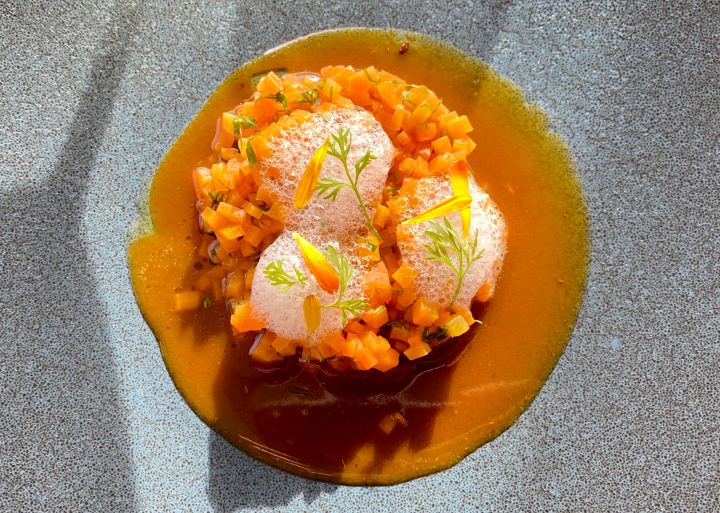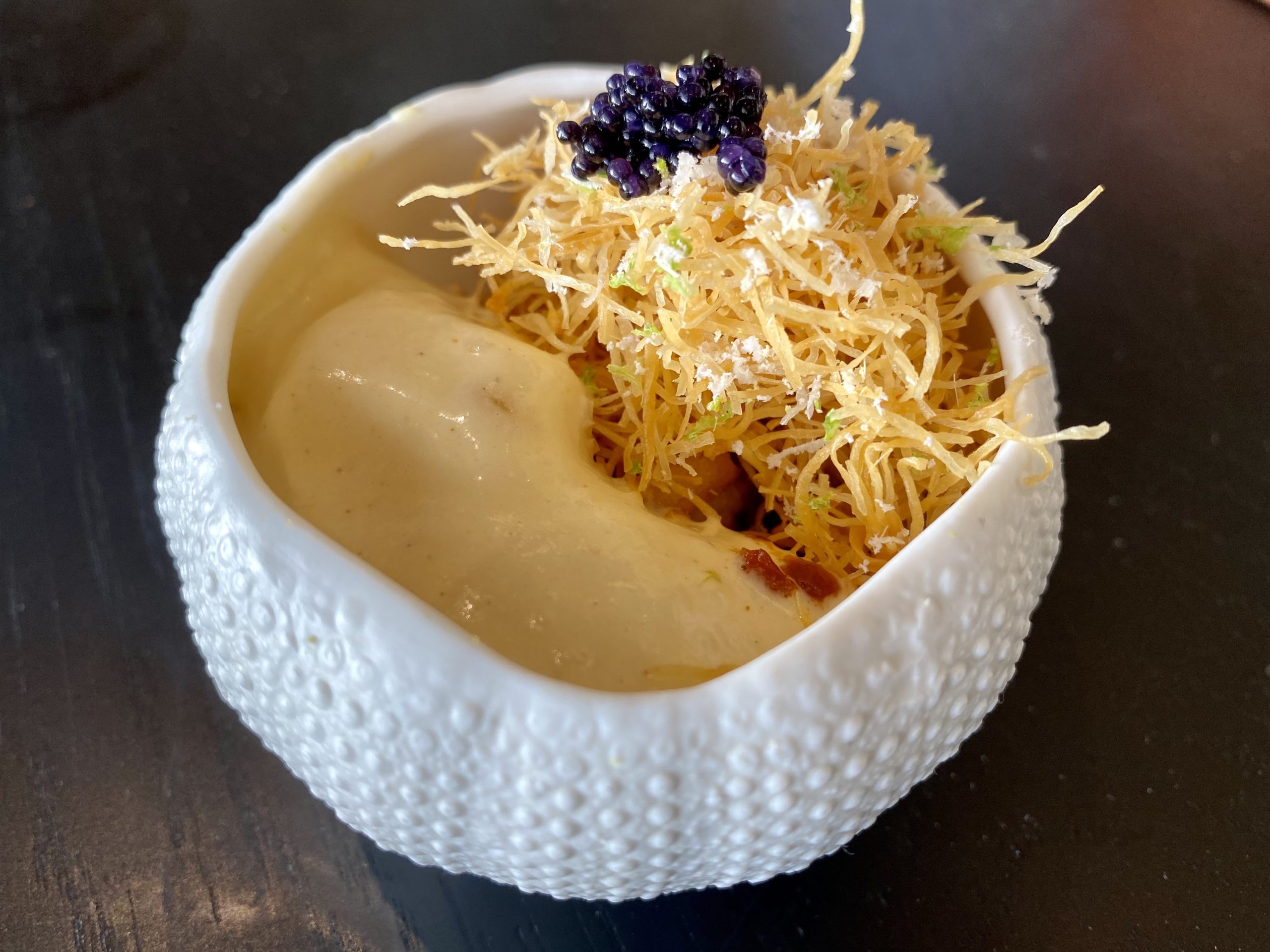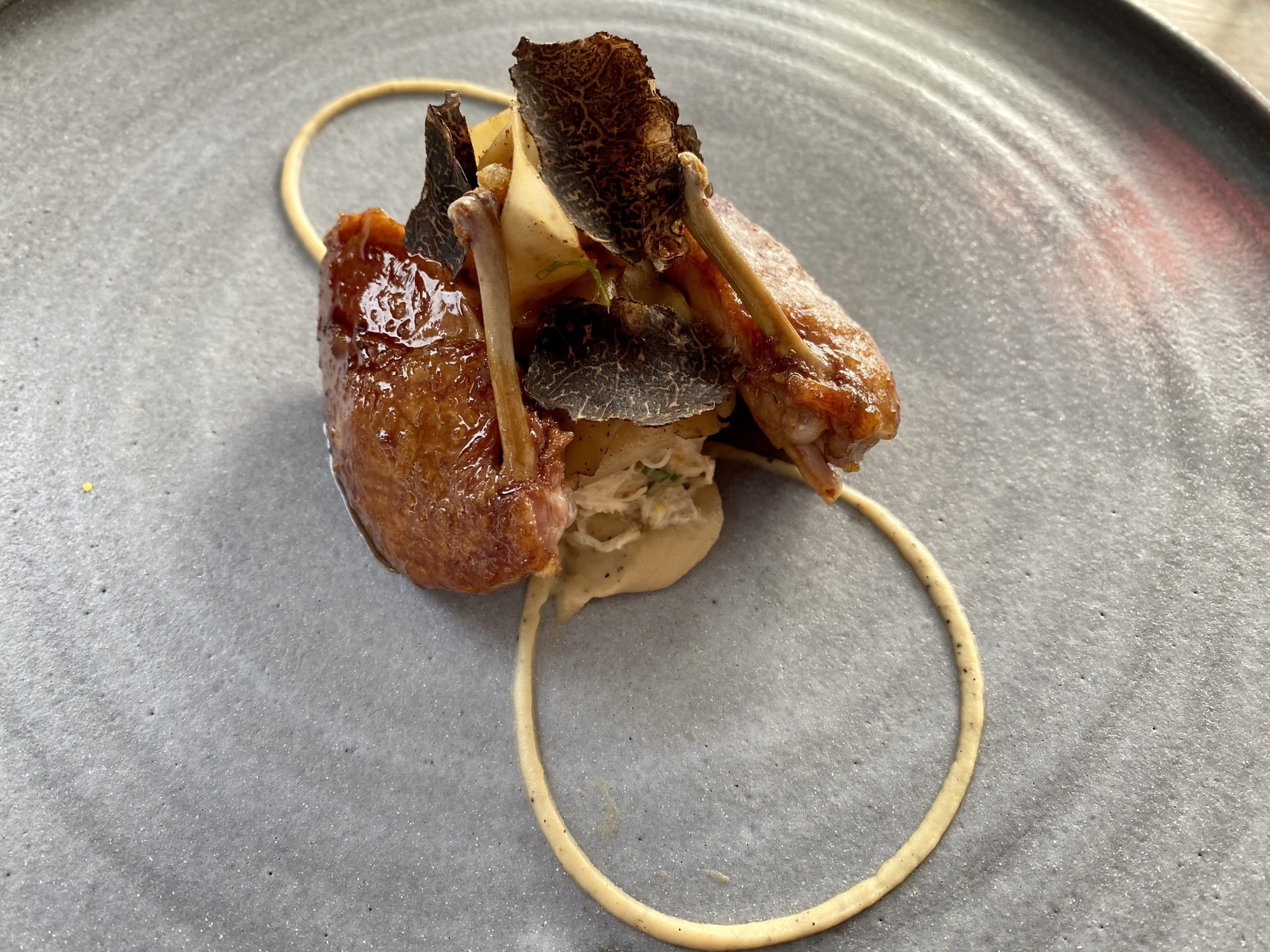BEST OF THE BUNCH
Chef takes carrots to the top in tapas

Head chef Braam Beyers at Chefs Warehouse Tintswalo Atlantic has elevated the humble carrot from a sweet side dish with a Sunday roast to the star of the tapas show.
Carrots. We’ve all got childhood stories about them – some trauma possibly. Not as much as Brussels sprouts, but still.
“Eat your carrots, they’re good for your eyesight,” our mothers and grandmothers told us, as we pushed the soft cubes drenched in butter and brown sugar around the plate, or hid the raw carrot sticks that found their way into our lunch boxes. Another promised benefit was curly hair, which turned out to be a blatant lie. The eyesight part is true though. Carrots contain beta-carotene, a substance that the body converts to vitamin A, an important nutrient for eye health.
Vitamin A is also found in kale (yuck), spinach, liver (one is advised not to consume more than once a week due to how much vitamin A it contains), and sweet potatoes. Another fun fact is large amounts of beta-carotene can turn a person’s skin orange.
Even if you like carrots, how likely are you – as a non-vegetarian – to order a purely carrot dish at a restaurant? I’m guessing not very. And no one would blame you, because nothing much exciting has been done to a carrot. Until now.
Chefs Warehouse Tintswalo Atlantic opened towards the end of 2020 with Braam Beyers, 25, as head chef – and partner with CW founder Liam Tomlin. Beyers always wanted to be a chef, since his school days (which to be fair, are not as long ago for him as for others). He’d come home and cook for himself every day, and later began sharing his recipes on his Braam Loves Food blog. Driven by a single-minded focus, Beyers always had the intention of being a chef, being a restaurateur, and being a businessman. He’d lie awake in bed at night, dreaming of this future.

Chef Braam Beyers, who has dreamed of a career in the kitchen since he was a wee lad. (Photo: Bianca Coleman)
“I do what I do and what I believe in, and what I enjoy. I always try to surprise myself and I think the reason I’m like this I guess, is because if you think about something for 10 years every day when you wake up and when you go to bed, your brain develops. It grows there and that’s how I believe it happened,” he said. “And also just hunger,” he added. “I worked in pretty much all my holidays when I was still a student.”
From high school, Beyers enrolled at Hurst Campus for a three-year hospitality and management chef course, but too much time in classrooms and not enough in kitchens was not what he was after. Then in the third year of the course, Beyers was offered the opportunity to go to Institut Paul Bocuse in Lyon. There, things fell into place.
During his studies, Beyers had approached Ivor Jones who was then at The Test Kitchen about doing a placement. It didn’t work out, but one night while in France, Beyers saw an Instagram post by Jones about the new restaurant he was involved in. Long story short, it was Chefs Warehouse Beau Constantia and refusing to take no for an answer a second time, Beyers did his exams, graduated, moved to Cape Town and began work as a demi chef. From there he moved up through the ranks: chef de partie, senior chef de partie, junior sous, senior sous, never skipping a position.
“I met Liam way back when,” shared Beyers. “My dad loves food so whenever he came down from where he was working in west Africa, he would take me and my sister out for lunch. One of those places was Chefs Warehouse Bree Street and I met Liam and Jan. I was probably in grade 11 at the time. I didn’t know who he was until I read his book.”
As head chef at Tintswalo, Beyers is completely in charge of the menu and the food. “I don’t need to ask permission. The only time I have to do that is if I want to spend big amounts,” he smiled.

Soft, warm, pillowy kitka is the first thing to come to the table, and it’s difficult to resist filling up on it. (Photo: Bianca Coleman)
While it differs slightly from one establishment to another, the Chefs Warehouse concept – or brand to which all the chefs remain true – is tapas for two to share, with a total of eight courses which can be presented individually or, as Beyers does it, in four courses of two dishes each. Of those two dishes, one can be individually plated while the other is designed to share. Diners are advised which one of the two to eat first.
Each of the two dishes are considered and calculated. “I did a reshuffle recently; if you ate the ceviche before the tartare, the tartare would fall flat. I would probably die for that dish just to prove a point,” he said.
The meal begins with the softest warm kitka with a shiny golden glaze, and house-made butter with za’atar and dukkah. It takes enormous restraint not to shove the entire thing in your mouth, especially when you know multiple courses will follow. The first of those is the linefish ceviche which is covered in a coconut broth and garnished with lacto-fermented daikon and sweet and savoury pearls. The beef sirloin tartare is instantly Instagrammable, secreted beneath shaved cured miso egg yolk and dotted with whipped chestnut and black garlic emulsion.

Aged beef sirloin tartare with whipped chestnut and black garlic emulsion, and shaved cured miso egg yolk. (Photo: Bianca Coleman)
“The tartare is also art,” said Beyers. “It has a rustic feel. I love eggs. I cooked eggs on toast every single day and when I told people I wanted to be a chef they laughed at me. My sister and her friends were like, ‘literally all you make are eggs!’. So that dish is a little bit of childhood as well.”
Course two is confit trout with green mango atchar, heirloom tomato salad and Cape Malay fish bone butter sauce; and a sexy and luxurious little fricassee of langoustine and leek with shrimp XO and champagne sabayon.
The former is to share, the latter is individually served. Some dishes just don’t lend themselves to be shared and are therefore plated separately, said Beyers.

Fricassee of langoustine and leek with shrimp XO and champagne sabayon. (Photo: Bianca Coleman)
The final courses include glazed quail with variations of celeriac, roasted quail jus and shaved black truffles; seared tuna with Jerusalem artichokes, barbecued pine ring mushrooms, and smoked cashew nut; and pea risotto with lemon compressed broccoli shavings and chargrilled broccoli beurre noisette.
“The pea risotto is simple as risotto is a staple in the CW brand; we must always have one on the menu,” explained Beyers. “We wanted one that is light and fresh and vibrant. That’s why you have lemon compressed broccoli, which is also a little bit of theatre. The crunch and freshness pairs well with truffle and quail.
“The Jerusalem artichokes with tuna was a bold move. I don’t know what I was thinking but it works apparently.”

Glazed quail with celeriac, and yes, shaved black truffles. (Photo: Bianca Coleman)
When is she going to get to the darn carrot, you must be thinking. When asked what his favourite dish is, Beyers has no hesitation in saying “the carrot”. It really is quite amazing.
It begins with a pumpkin seed and walnut dressing as the base, upon which tiny cubes of carrots are laid. There is burnt thyme foam, and on the side, pumpkin seed tuiles with symmetrical rows of pumpkin seeds (and there is no photo of those because they didn’t last long enough) and an earthenware bowl of carrot ricotta. The whole lot gets spooned onto the tuile and into your mouth.
But it’s not that simple. This is the most labour-intensive carrot dish you’ll ever eat.
When his supplier ran out of beetroot and Beyers was thinking of a replacement, his mind went straight to textures of carrot. “Initially I thought of carrot tartare, cubed all cut by hand, then what do I like with carrot? I like walnuts. Pumpkin seeds, something smokey. Then because you’re cubing all the carrots there’s shitloads of off cuts – what do you do with them? We juice them and make a sauce. I’ve recently been finding a passion for art and design, so how can I do this, something served on linen or on trays, like a vessel. What do we use as a vessel? Pumpkin seed tuiles all facing the same direction so we can deliver an interactive dish. Then I thought about ricotta – it goes well but it’s too basic. What do I do? How do I make it art? Make a carrot ricotta. I figured that out, with marbling piped lines like marbre roche. Cool, but I can make it better; to finish the dish, use the carrot tops, pick them and garnish on the burnt thyme foam … now we’re getting somewhere.
“You only realise your concept is coming together when you do it and you see the art. The first day I came in at 6.30am and cut carrots for four fucking hours. I cut them raw because you can keep a perfect form, one millimetre by one millimetre. No one else was allowed to do it at first.”
This is how Beyers talks and is a small window into his mind, which is constantly firing on all cylinders, always planning, always figuring out the dishes in his head first then coming into the kitchen and making them straight away. This one took a whole two days. “Generally, I think about the procedures if I’m familiar with the produce. If not, I’ll sit with it in front of me, scratch it, look at it, stare into thin air, taste it raw…then I understand what I want to do with it. My movements are pretty much all calculated every time, so not much trial and error.”

Seared tuna with Jerusalem artichokes. (Photo: Bianca Coleman)
He’s precise and he’s focused. That is his personality.
Does he ever relax? “No. No. I really struggle. I can’t. I can’t watch television. I exercise a lot and look after my health. I don’t really party any more. Rockstar mentality with this?” he gestured towards the restaurant and kitchen. “I need to be on it all the time. I spend a lot of time with myself. To be honest I’ve become quite antisocial. It’s interesting.”
In case the carrot dish is sounding a bit too simple, the cubes are confited in pine needle oil, which is made by burning needles over a flame, which releases their aroma. The carrots spend exactly nine minutes in the oil or the texture will not be perfect. They’re vacuumed packed in exactly 35g portions which are dunked in a water bath for service.
Prep is done the day before. “In the beginning I was staying after service, with a glass of wine. I’d chop till midnight,” said Beyers. “The sous chef does it now and I’m comfortable with that. It’s a special dish – and not only the design. People, whether they know it or not, it’s for them to figure out the amount of hard work the guys put into it – the conditioning for your brain to be so disciplined to stand there and cut these little cubes for hours on end,” he said.
“I’m very proud of the dish. It’s art and I’m not saying it in an arrogant way. I know what I like and I know what impresses me. Hopefully that works for everyone else.”
I promise you will never look at a carrot the same way again. DM/TGIFood
Chefs Warehouse Tintswalo Atlantic





 Become an Insider
Become an Insider
Comments - Please login in order to comment.